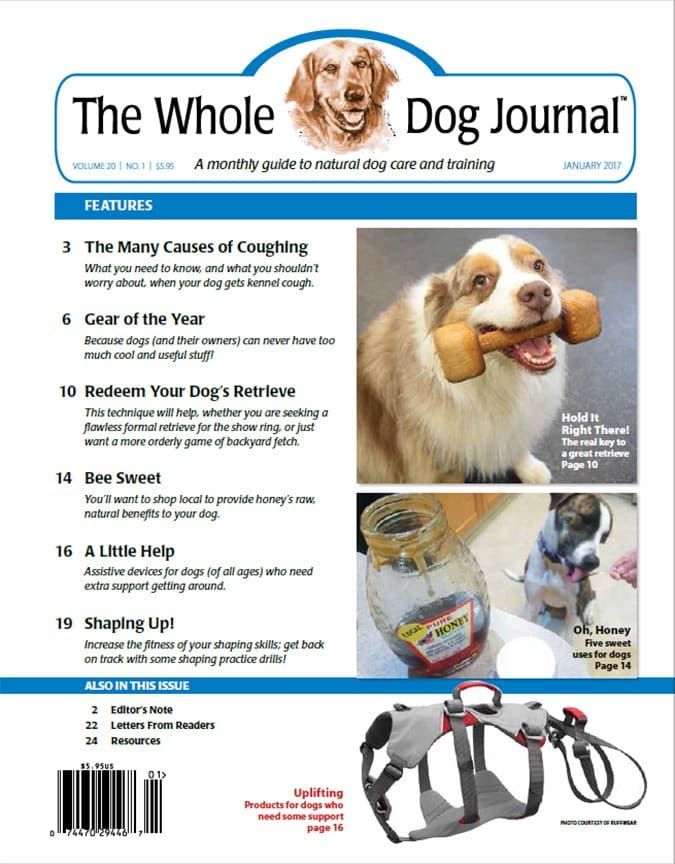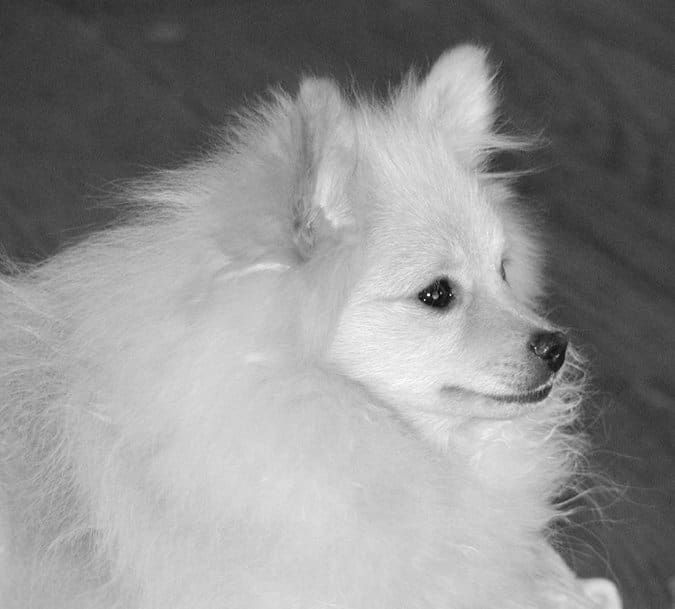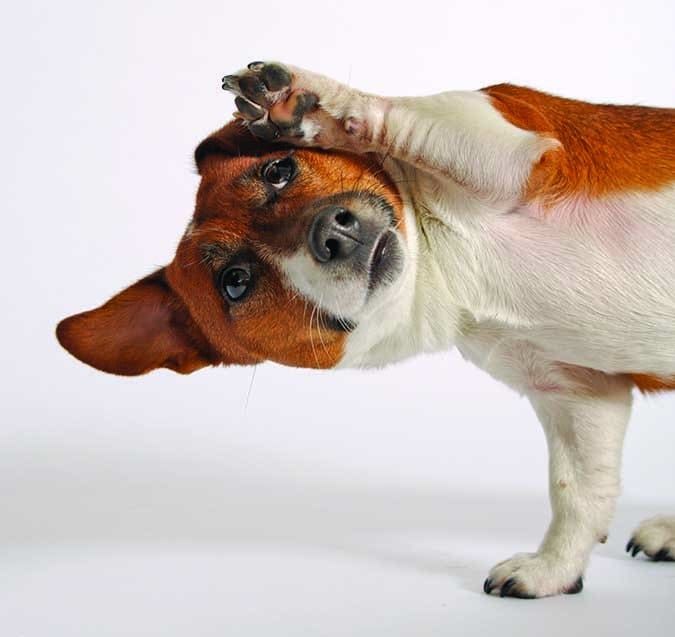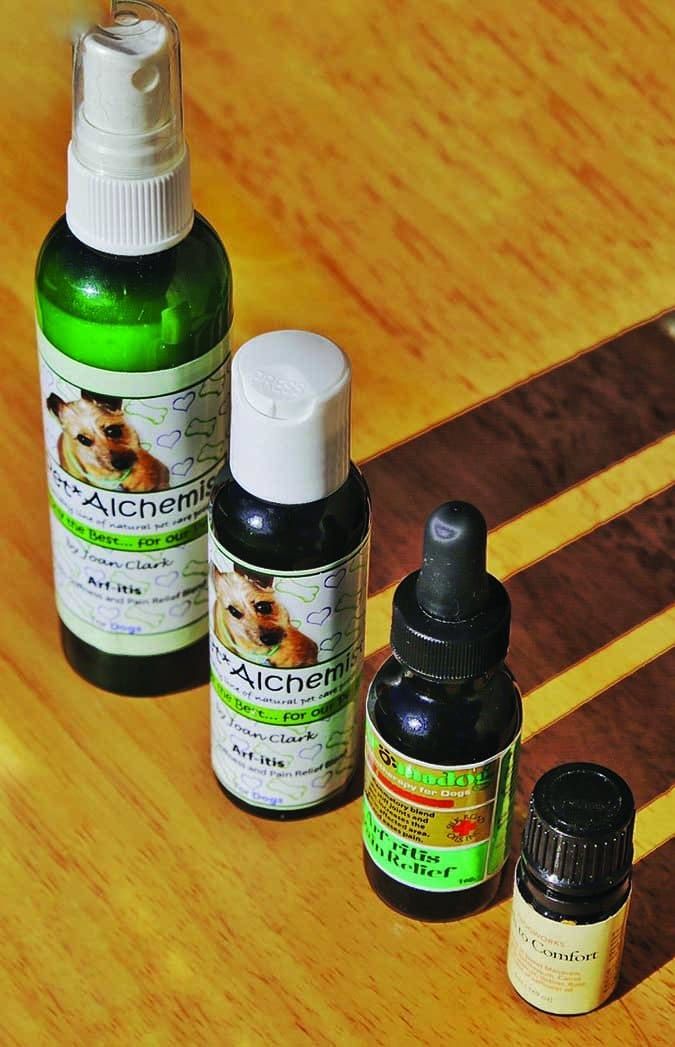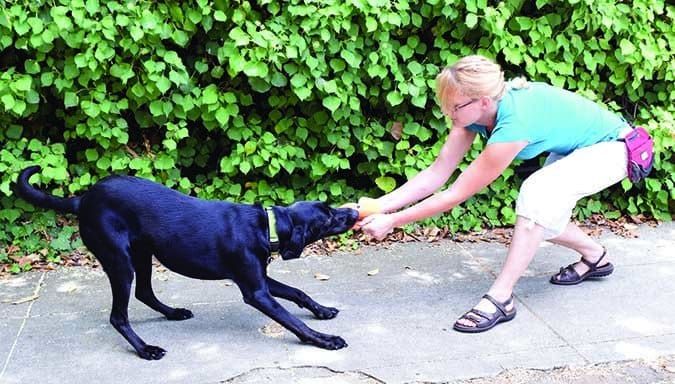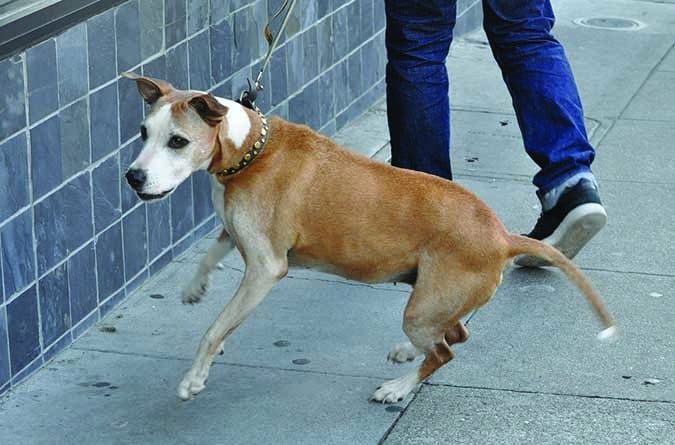Download the Full January 2017 Issue PDF
Mixed-Breed Puppies Are Like a Box of Chocolates
Last summer I fostered a really disparate-looking litter of puppies for my local shelter. Most of the time, whether they are brought in as purportedly “found” puppies or their owners admit that they were accidental and unwanted, the litters of puppies that come to the shelter are fairly uniform, like the litter of 11 Great Dane pups I fostered immediately after the dissimilar group (there were 10 black and white pups, and one fawn-colored one, who nevertheless was the exact same shape and size as his siblings). But this one litter looked like they were from three different families!
As a side note, I should mention a fact that surprised many of my friends and family members, but isn’t news to experienced dog owners: puppies from the same litter can have different fathers. Each of the mother’s egg cells need to be fertilized by individual sperm cells, and if the mother has been bred by a number of males, the eggs can be fertilized by sperm of different males. When the owners of intact females fail to keep them safely separated or sequestered, and they escape and run loose, or loose, intact males are drawn from all over the neighborhood to them, anything can happen!
So, the odds are good that the pups who looked so different from each other were sired by at least two different dads – at the time that I was caring for them, I thought maybe even three or four fathers!

There were seven pups. Three looked pretty similar to each other, sort of like hound/German Shepherd-mixes, with short, reddish/tan coats with darker “saddles” on their backs.

Two others had short, black coats, with brown spots over their eyes and on their legs; they looked like Rottweiler-mixes.
One puppy had a very fluffy, long coat, but the color was similar to the hound/shepherd-looking pups.
And the last puppy was also quite fluffy/long-haired, but had a dark sort of black/dark-grey outer coat, and a lighter undercoat. She also had a naturally bobbed tail!

As it turns out, I know where four of the seven pups landed, and recently saw the bob-tailed pup in person. I am friends on Facebook with the owner of the other long-haired pup, and have seen photos of her more or less weekly since her adoption. When I saw the bob-tailed pup -well, now she’s an adolescent dog – I was temporarily confused. Her color has lightened and gotten much more red, and she looks super similar to her long-haired sister! When they were pups, I would have sworn they were sired by different dogs, but now – except for the bobbed tail – they absolutely look like full siblings. Genetics are so strange!
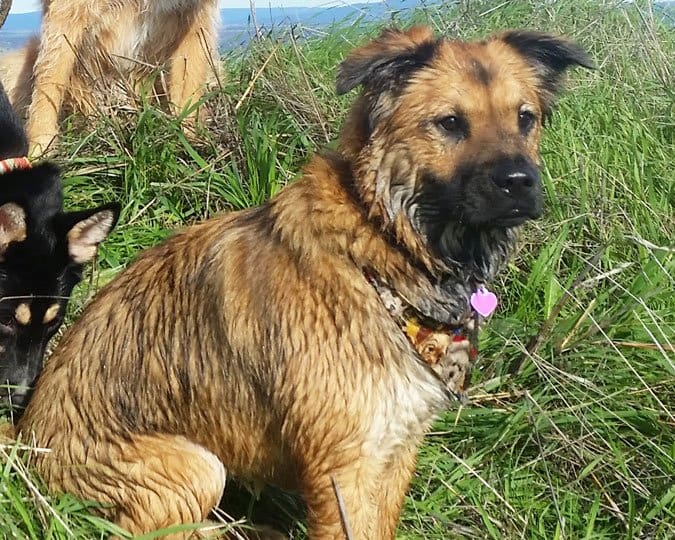
I was thinking about this because I’m currently fostering ANOTHER litter of seven mixed-breed puppies for my shelter. I don’t know WHAT they are, just that their cage-card read, “Mother, Husky-mix, DOA.” They definitely look related, but there are some striking differences among them. I think when these ones are ready to be adopted, I’m going to send along postcards asking the adoptive owners to keep in touch somehow, on Facebook or via email; I’d really love to see what they all look like, and I’m insatiably curious whether they will look similar or different as they mature.

This is absolutely not a knock on purebred dogs, but it occurred to me today, as I was kissing all these unique faces, that it might be boring when the pups all look very similar!
Thankful for Dog Vaccines
My husband and I were talking about childhood dogs for some reason, and he said, “We got a dog when I was little and it died of distemper, and my parents said, ‘That’s it, no more dogs.'”
When he said that, I suddenly remembered that my family, too, had lost a young dog to distemper when I was a child. I have a solid memory of my mother wiping up vomit, and the adolescent pup lying limply nearby, and my mother telling me, “I don’t think she’s going to make it.” I was probably about four or five years old, but I knew that this phrase meant the dog was probably going to die.
That memory compelled me to go look up the history of the canine distemper vaccine. Was it not available to the average dog owner in the mid to late 1960s? Or were our parents just irresponsible? Or what?

It turns out that both explanations were probable. The canine distemper vaccine became widely available only in the late 1960s – and neither my husband’s parents nor my own were particularly knowledgeable pet owners. It’s likely that the vaccine was something that was only newly available to pet owners, and not yet part of what every puppy from a responsible breeder or in a shelter received.
While some veterinarians still take a “wrap puppies in cotton wool” approach, advising owners to keep puppies sequestered at home until they are fully immunized – in order to prevent them from contracting any infectious disease – many others now consider puppies to be at a higher risk of developing social/behavioral disorders if they are prevented from socializing as puppies. Vaccination rates are so high today, that the deadliest canine infectious diseases are rare enough that taking pups into most environments is far safer than it was when I was a child.
Note that I said safer – not perfectly safe. Vaccination rates will never be 100 percent, and there are wildlife vectors that can bring diseases like distemper (and rabies) back into even very urban environments and set off waves of disease infection in areas where vaccination rates are low.
Today (here in the U.S., anyway), with effective vaccines being not just widely available, but also relatively inexpensive, I just can’t wrap my head around the idea of a highly contagious, highly lethal disease being so common that practically everyone who had a dog had heard of it, and knew someone whose dog died of it. I’m so grateful to have these lifesaving tools available, and I don’t take them for granted.
By the way, in the process of investigating the distemper vaccine, I came across a fascinating article about the race to develop the vaccine: “‘Saving the lives of our dogs’: The development of canine distemper vaccine in interwar Britain.” If you like dogs (and I don’t think you’d be reading this if you didn’t) and you like science-writing, you’ll enjoy this account of how competing scientists fought for understanding, funding and acclaim as they worked to defeat this terrible disease.
Canine Parvovirus Vaccine, Symptoms, and Treatment
When parvo strikes, it moves fast. Infected dogs may appear to be in perfect health one day and violently ill the next. Emergency veterinary care is expensive, and unless dogs are diagnosed and treated early, many die from this serious disease.
In this article, we’ll discuss a number of parvovirus prevention and treatment approaches taken by veterinarians and dog guardians today, including the parvo vaccine. We’ll also explain how parvo is spread among dogs, why it’s so dangerous, and the parvo symptoms to watch out for.
But first, let’s review the most common myths about canine parvovirus, and some facts about the disease:
PARVO MYTH 1: Adult dogs don’t get parvo.
TRUTH: It’s true that the likelihood of a serious parvo infection decreases as dogs age, and that most victims are puppies. But adult dogs can become seriously ill or die from parvo.
PARVO MYTH 2: I can protect my dogs from exposure to parvo by maintaining a clean environment and restricting their contact with other dogs.
TRUTH: The virus is everywhere, and it’s impossible to prevent parvo exposure.
PARVO MYTH 3: My dog is strong and healthy. His immune system will prevent him from getting sick.
TRUTH: Under the right conditions, any dog can be vulnerable to canine parvovirus disease.
PARVO MYTH 4: The parvo vaccine will protect my puppy.
TRUTH: Vaccinated puppies can get parvo under certain circumstances.
Reactions to parvovirus vary widely – both among dogs and their human caretakers. In a world in which parvovirus is ubiquitous – it is literally everywhere except environments that have been sterilized – parvo kills some dogs and leaves others unscathed. And in the debate about vaccination against this disease, some people vaccinate their dogs early and often, while others refuse to vaccinate against parvo at all.
One good reason to avoid taking your puppy to heavily trafficked public parks – at least until you have reason to believe his antibody levels are at protective levels – is the pervasiveness of parvovirus.
But we won’t tell you which approach you should take with your dog. That, like all health-related issues, is a personal decision that must be made after you learn as much as possible about the risks and benefits of the various approaches.
Why is Parvovirus So Dangerous?
Parvoviruses infect birds and mammals (including humans), but until the 1970s, parvovirus did not infect domestic dogs or their wild cousins. The original canine parvovirus, later labeled CPV-1, was discovered in 1967. Eleven years later, CPV-2 emerged in the United States. It apparently mutated from feline distemper, which is the feline parvovirus. CPV-2 quickly infected dogs, wolves, coyotes, foxes, and other canines around the world. A second mutation, CPV-2a, was identified in 1979, and a third, CPV-2b, is in circulation today. A more detailed history of canine parvovirus, with additional preventative tips, see “Parvovirus in Dogs: What It Is and How to Prevent It,” (February 2017) by Barbara Dobbins.
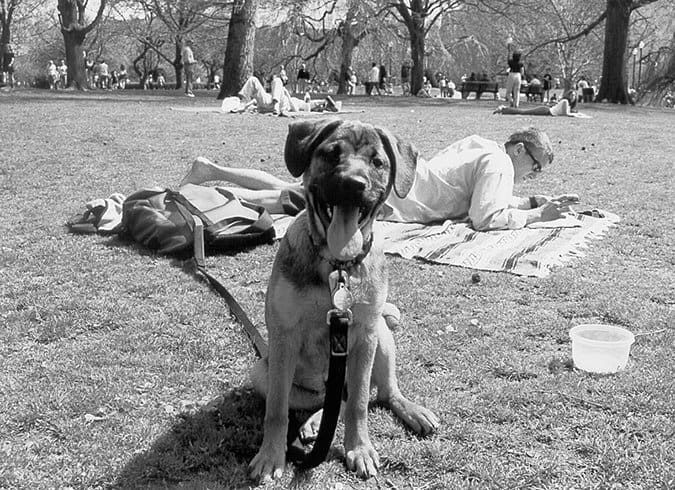
The smallest and simplest of the microscopic infectious agents called viruses, which cause disease by replicating within living cells, parvovirus consists of a single strand of DNA enclosed in a microscopic capsid, or protein coat. This protein coat, which differs from the envelope of fat that encases other viruses, helps the parvovirus survive and adapt.
Infection takes place when a susceptible host inhales or ingests the virus, which attacks the first rapidly dividing group of cells it encounters. Typically, these cells are in the lymph nodes of the throat. Soon the virus spills into the bloodstream, through which it travels to bone marrow and intestinal cells. The incubation period between exposure and the manifestation of symptoms such as vomiting and diarrhea is usually three to seven days.
When it attacks bone marrow, parvo damages the immune system and destroys white blood cells. More commonly, it attacks the intestines, causing copious diarrhea and debilitating nausea, which further weakens the dog’s system. Dogs who die of parvo typically do so because fluid loss and dehydration lead to shock, and/or because intestinal bacteria invade the rest of the body and release septic toxins.
Any dog who survives a parvovirus infection is believed to have lifelong immunity; serum antibody titers tend to stay high for prolonged periods after recovery from the virus.
Young puppies and adolescent dogs whose maternal antibodies no longer protect them but whose immune systems have not yet matured are at greatest risk of contracting parvo. Most parvo victims are less than one year old, but the disease can and does occasionally strike adults, too.
Some breeds are particularly susceptible to contracting parvovirus, including Alaskan Sled Dogs, Doberman Pinschers, German Shepherd Dogs, Labrador Retrievers, Rottweilers, and American Staffordshire Terriers.
How Parvo Spreads to Dogs
Veterinary experts agree that virtually all of the world’s dogs have been exposed to canine parvovirus. The virus begins to “shed,” or be excreted by a dog, three to four days following his exposure to the virus, often before clinical signs of the infection have appeared. The virus is also shed in huge amounts from infected dogs in their feces for 7-10 days; a single ounce of fecal matter from a parvo-infected dog contains 35,000,000 units of the virus, and only 1,000 are needed to cause infection.
In addition, the virus can be carried on shoes, tires, people, animals (including insects and rodents), and many mobile surfaces, including wind and water. Because it is difficult to remove from the environment and because infected dogs shed the virus in such profusion, parvo has spread not only to every dog show, veterinary clinic, grooming salon, and obedience school, but every street, park, house, school, shopping mall, airplane, bus, and office in the world.
While a dog that is diagnosed with parvo will be quickly isolated by his veterinarian and his recent environment will be cleaned and disinfected, some infected dogs have such minor symptoms that no one realizes they are ill. Infected dogs, with or without symptoms, shed the virus for about two weeks. If conditions are right, the virus can survive for up to six months. Although parvo is destroyed by sunlight, steam, diluted chlorine bleach, and other disinfectants, sterile environments can be quickly reinfected.
Parvovirus Symptoms to Watch For
Here are the signs of parvo you should not ignore if you suspect your dog has been exposed. It is important to remember that most parvovirus deaths occur within 48 and 72 hours following a dog showing clinical signs.
– sudden inappetance (dog won’t eat)
– vomiting
– extreme lethargy or depression
– diarrhea (severe and/or containing blood)
– dehydration
– a bloated, tender, or seemingly painful abdomen
– rapid heartbeat
– red gums and eyeballs
– low body temperature (hypothermia)
Canine Parvovirus Medical Treatment
Most veterinarians treat parvovirus with intravenous fluids and antibiotics. In addition, treatment may include balancing the blood sugar, intravenous electrolytes, intravenous nourishment, and an antiemetic injection to reduce nausea and vomiting. None of these treatments “cure” the disease or kill the virus; they are supportive therapies that help stabilize the dog long enough for his immune system to begin counteracting the virus.
According to Los Angeles veterinarian Wendy C. Brooks, DVM, “Every day that goes by allows the dog to produce more antibodies, which bind with and inactivate the virus. Survival becomes a race between the damaged immune system, which is trying to recover and respond, and potentially fatal fluid loss and bacterial invasion.” Puppies and very small dogs are at greatest risk because they have the smallest body mass and can least afford to lose vital fluids.
Bill Eskew, DVM, sees more parvo patients than many veterinarians because he specializes in emergency care. A veterinarian for 25 years, Dr. Eskew currently works in busy clinics in California and Florida. He says fluids and electrolyte balance are the most important aspects of parvo treatment.
“My typical parvo patient is a four-month-old unvaccinated or partially vaccinated puppy,” says Dr. Eskew, “and I see as many as 20 a week. I’m convinced that of all the treatments we use, intravenous fluids make the most difference. In one case I treated a litter of puppies for a man who couldn’t afford antibiotics or other drugs, so I used fluids alone, and the pups all recovered. In fact, as far as I know, all my parvo patients have survived.”
While antibiotics have no effect on viruses, they are considered an important aspect of treatment, especially for puppies. The parvovirus causes the gastrointestinal mucosa, which usually serves as a protective barrier to infection, to slough away, leaving the puppy vulnerable to bacterial infections. Antibiotics protect the puppy from infection until his body’s own system of protection recovers.
Parvovirus Treatment Costs for Dogs
Many dogs diagnosed with parvovirus receive the fate of “economic euthanasia” because their guardians cannot afford treatment. Standard parvovirus treatment necessitates round-the-clock veterinary attention, which means hospitalization, which means a gigantic medical bill. Parvovirus treatment for a single puppy typically starts at $1,200 and can reach over $5,000. Anyone without significant financial means is faced with a horrifying choice: owe money they cannot pay back, or euthanize their sick dog.
Without intensive care, an already parvo-infected dog’s chance of survival is slim to none. There is, thankfully, one alternative to hospitalizing a dog for parvo that can cut the cost of treatment by over half the price. Colorado State University has created an outpatient protocol for canine parvovirus patients, used mostly by animal shelter staff and dog foster guardians, but which any dog owner can receive the proper training for.
The parvovirus outpatient protocol requires owners to nurse their dogs 24/7, at their own homes, administering fluids and antibiotics, syringe-feeding, and monitoring every step of their dog’s progress. Owners pay for the drugs and fluids plus some additional fees, which total around $400. Although most people will be unable to take time off work or find space in their home, the significantly lighter cost of this treatment makes it an important option. Read “New Home Treatment for Parvo May Prevent ‘Economic Euthanasia’,” for further details.
Canine Parvovirus Recovery Rates
According to Dr. Brooks, an estimated 80 percent of parvo-infected dogs treated at veterinary clinics recover.
Dr. Eskew credits his success rate to early diagnosis. “The minute we see a puppy that’s been vomiting or has diarrhea,” he says, “we give it a parvo test. The one we use is a rectal swab that shows results within 10 minutes.”
Of course, such early detection tools can be used only if the dog’s guardian is alert to the early signs of illness and hustles him to the veterinary clinic as soon as possible. The sooner the dog receives supportive care, the better his odds of recovery.
Parvovirus Vaccines: Imperfect Protection
Properly administered, vaccines protect most puppies and dogs from parvovirus. But there are cases of vaccinated canines contracting the disease.
In late 1998, Whole Dog Journal received a letter from a reader whose nine-month-old puppy had contracted (and, happily, recovered from) parvovirus. She was perplexed as to how her properly vaccinated puppy could have become infected, especially since she also owned a brother from the same litter who did not become sick, even though both pups had received the same vaccinations and had been exposed to the same things and places!
The experience of the letter writer’s next-door neighbor added to the mystery. After hearing about the puppy with parvo, the neighbor took her six-month-old, vaccinated puppy to the veterinarian for titer tests, to make sure this puppy was protected. The test indicated that the puppy had no immunity to parvovirus, so she had the pup revaccinated immediately.
For explanations for all these puzzling events, we turned to Jean Dodds, DVM, an expert in veterinary hematology and immunology. Dr. Dodds is also founder and president of Hemopet, of Garden Grove, California. Hemopet is a national nonprofit animal blood bank and adoption program for retired Greyhounds.
Dr. Dodds offered numerous explanations as to why, sometimes, the parvovirus vaccine fails to work as intended.
First, she made clear, no vaccine produces 100 percent protection 100 percent of the time. “Vaccination is not a sure thing,” she explained. “It certainly improves the odds that an animal will be protected from disease, but it does not guarantee this. There is no way, even with the best vaccines, to be sure that any given individual’s immune system will respond in the desired way to protect that animal.”
Not all dogs have perfectly functioning immune responses, and, similarly, not all vaccines function perfectly, either. “There will always be an occasional case of a ‘vaccine break,’ which is what we call it when a vaccine fails to protect an individual against an infectious disease challenge,” said Dodds. “However, when a break occurs, if the animal has been appropriately vaccinated, it will usually experience only a mild form of the disease.” Dr. Dodds speculated that this is the most probable explanation for what happened with the infected puppy mentioned above.
“While there are some rare exceptions, where an appropriately vaccinated animal nonetheless experiences a lethal form of the disease, it is far more typical that such an animal will experience only a mild form of the disease and will recover quickly,” she said.
However, the most common reason for vaccine failures in puppies is maternal antibody interference. Dr. Dodds explained that if a puppy receives a particularly high level of antibodies (passive immunity) from his mother’s colostrum (and to a lesser extent, in utero), these maternal antibodies may cause any vaccine antigens that are administered to be neutralized. Then, when these antibodies wane (usually between 6 and 16 weeks of age), the puppy is left without adequate protection, and has not become actively immunized.
“Maternal antibodies wane at an unpredictable rate, which is why puppies are vaccinated several times at intervals of two to four weeks apart,” said Dr. Dodds. “This was designed in an effort to cover any potential gap in protection or ‘window of susceptibility’ that arises from the waning of maternal passive immunity and the onset of active immunization and protection by vaccination.”
Because of this, a test for serum antibody titer or an additional vaccination is sometimes recommended at 15-16 weeks, especially in high-risk breeds.
Whole Dog Journal editor Nancy Kerns discusses puppy vaccines and maternal antibody interference in detail in the October 2016 issue: “Puppy Vaccines: Why Your Puppy Needs So Many Shots.”
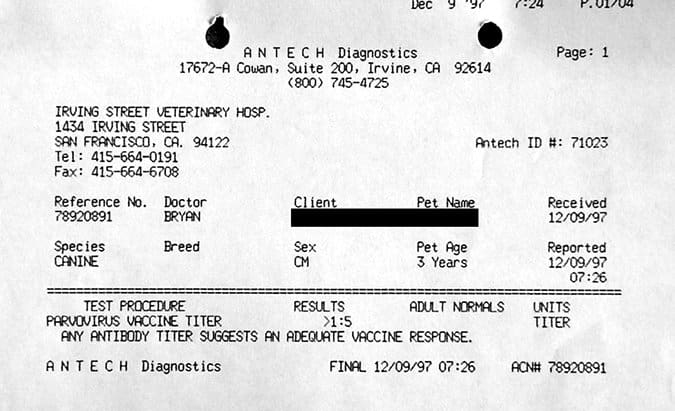
Parvovirus Vaccine Titers: Not Always Helpful
Regarding the neighbor’s vaccinated puppy, whose antibody titers showed no antibody protection for parvo: Dr. Dodds thinks that the chances are very good that the puppy actually did have adequate protection from parvovirus, despite the misleading titer test results.
“There are two types of titer tests commonly offered by most veterinary medical laboratories,” Dr. Dodds explained. “One type is intended to detect whether or not a dog has the disease (a viral infection); the other type of titer test checks the level of immunity the dog received from vaccination. In the latter case (a vaccine titer test), antibody levels are expected to be several titer dilutions lower than those conveyed by active viral infection.
“When a veterinarian requests an immunity or antibody level measurement for parvovirus or other disease, the laboratory typically assumes that disease diagnosis, rather than vaccine immunity, is to be performed. When the lab technicians do a test to see whether the dog has parvovirus, they start with a much greater dilution in the test system than is normally used for the detection of vaccine titers. They do this to conserve reagent and reduce cost of testing. But because vaccine titers are lower than disease titers, they won’t be detected until the test reagent dilution is set lower.
“I’ll put it a different way: If they utilize disease exposure methodology, when what is really wanted is a test to assess the adequacy of vaccination, the results will be negative nearly every time,” said Dodds.
While this scenario sounds like an obvious oversight, Dr. Dodds said she has seen it numerous times. Given her expertise and research on vaccine-related issues, many veterinarians consult with Dr. Dodds regarding supposed vaccination failures.
“I’ve seen it again and again: The owner calls me and says, ‘But I keep vaccinating this animal, and my veterinarian keeps testing him and there is no immunity; what do I do?!’
“Very often,” said Dr. Dodds, “it’s a case where the veterinarian looked at the lab catalog and selected the test called ‘Parvovirus Antibody’ rather than the intended one, which would be ‘Parvovirus Vaccine Antibody’ or ‘Parvovirus Vaccine Titer.’ Meanwhile, the poor animal has been vaccinated repeatedly and unnecessarily, and when we finally get the correct measurement, we find that the animal actually had good immunity all along.”
Not Necessarily Parvo
Back to the puppy who was vaccinated but was stricken with parvo anyway: A final explanation is that his illness might have been incorrectly diagnosed. Dr. Dodds explained that veterinarians diagnose parvo by its symptoms – fever, depression, diarrhea, vomiting – and by checking the dog’s stool for presence of parvovirus or serum antibody level. But other gastrointestinal diseases can produce symptoms that closely resemble those of parvo. And even the presence of low levels of parvovirus in the stool doesn’t necessarily mean that parvo is causing the dog’s symptoms.
“Dogs who are vaccinated and fully protected against parvovirus may still shed the virus in their stool if they are exposed to the disease agent,” said Dr. Dodds. “Unless the stool sample revealed a moderate to heavy parvovirus infection, I would suspect that the dog’s symptoms are caused by something else, or a combination of parvovirus exposure and another infectious agent. For example, the puppy could have been exposed to both parvovirus and corona virus, and then suffered diarrhea and other symptoms as a result of the corona virus alone, because he was adequately protected by vaccination against parvovirus.”
Parvo Protection for Unvaccinated Dogs
Can a superior diet protect unvaccinated dogs against parvo? When parvovirus first infected the world’s dogs, thousands credited Juliette de Bairacli Levy’s Herbal Handbook for the Dog and Cat and its Natural Rearing philosophy for saving their dogs’ lives. Levy was the first to advocate a well-balanced raw, natural diet for pets. Read “A History of Holistic Dog Care,” (WDJ, July 2006) to learn about Levy’s Natural Rearing method.
Marina Zacharias raised four Basset Hound pups on the Natural Rearing diet. When they were six months old, they played with a puppy the day before it was diagnosed with parvo. “For 10 days after exposure, I gave them one of Juliette’s disinfecting herbal formulas plus homeopathic remedies to help boost their immune function,” she says. “On the tenth day, one of my pups started to show symptoms so I treated it with castor oil to help sweep away the virus as Juliette describes in her book, and I continued with homeopathics. Within two hours this pup was completely back to normal. The other three never showed symptoms and remained healthy.”
Zacharias has received similar reports from numerous clients whose raw-fed, unvaccinated puppies were exposed to parvo. Homeopathic nosodes, which are highly diluted remedies made from the disease material of infected animals, have become popular alternatives to conventional vaccines. But many veterinary homeopaths believe their use as surrogate vaccines is inappropriate.
One is Maryland veterinarian Christina Chambreau, who explains, “The best time to use a homeopathic nosode is after exposure. If you know your dog has been exposed to parvo, you would give a single dose of a 200C-strength homeopathic parvo nosode. This treatment can be given any time after exposure and before the animal gets really sick, such as when it shows minor symptoms like throwing up once or having soft stools.”
Dr. Chambreau says she is aware of about 50 cases in which unvaccinated or minimally vaccinated litters of puppies, kennels of dogs, or individual dogs were exposed to parvo, and after a single treatment with the parvovirus nosode, either did not get the disease at all or had only minor symptoms.
Dr. Chambreau also recommends feeding the best possible diet and boosting the dog’s immune system with supplements such as vitamin C and infection-fighting herbs like echinacea. It is not uncommon, she says, for holistically raised, unvaccinated puppies to have parvo without being diagnosed.
“Many of my clients choose not to vaccinate at all,” Chambreau says, “and it’s not uncommon for their puppies to get sick with a mild case of diarrhea or vomiting that we treat homeopathically or with other holistic therapies. These puppies recover quickly, and what’s interesting is that later, when they’re directly exposed to parvo, they don’t catch it. That minor bout of diarrhea was probably parvo. It’s possible to raise puppies so that they get a natural exposure rather than a vaccine exposure to parvo, and that builds a better immunity than the vaccine in most animals.”
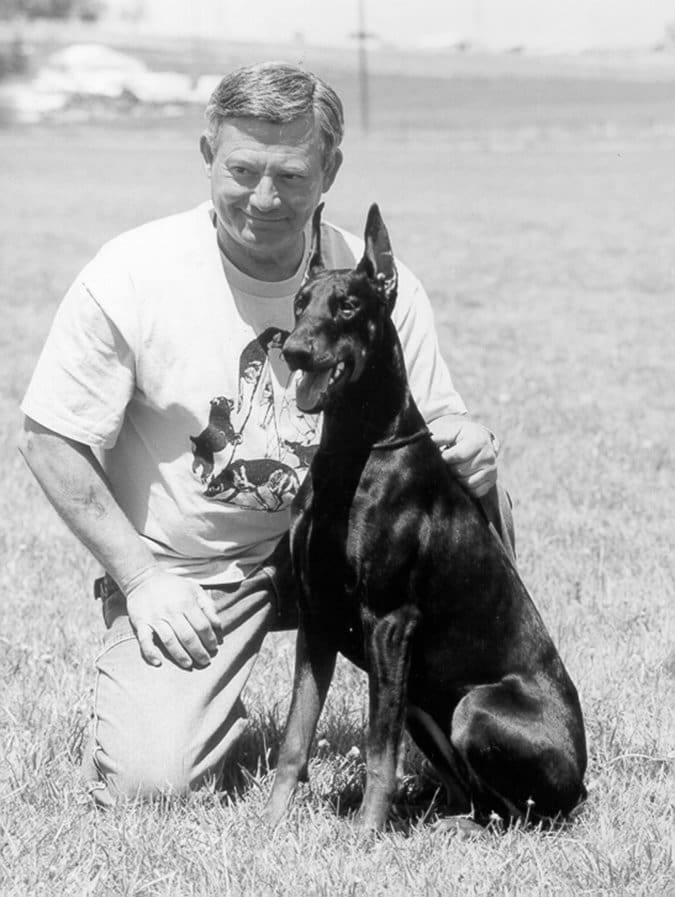
California veterinarian Gloria Dodd first dealt with parvovirus when it appeared 20 years ago. “When parvo first mutated from the Feline Distemper virus, it hit the canine world hard,” she says. “Here was an entire population with no immunity to this new viral infection. In a single week, I was overwhelmed with 55 dogs that had severe clinical infection with bloody diarrhea, vomiting, dehydration, and shock.” The virus affected dogs of all ages, from puppies to 15-year-old dogs with congestive heart failure and others with liver and kidney disease.
“To treat this new illness,” she says, “I made an autoisode. An autoisode is a homeopathic remedy made from the secretions, excretions (saliva, urine, or feces), blood, and hair of the infected animal, for these substances contain the infective agent. I used them to make a sterile intravenous injection and gave this to all of the animals. I didn’t lose a single patient.”
The 30C potency parvovirus autoisode that she made during the epidemic has become the basis of her homeopathic parvo prevention, and she is not aware of any animals, either her own or her clients’, breaking with parvo. “On the contrary,” she says, “it has proven to be protective for unrelated infections by building and strengthening the dog’s own immune system to ward off other infective agents. When I gave it to a Connecticut kennel of Boston Terrier show dogs, they were the only dogs that did not contract kennel cough during an outbreak at a dog show in Massachusetts.”
Do You Need to Vaccinate Your Dog for Parvovirus?
We want our dogs be healthy and to live forever. Conventional veterinarians see parvovirus as an easily prevented, unnecessary illness, and vaccination as a simple, inexpensive component of basic care. Many holistic vets take a different view, and the possible damage vaccines cause is a concern for many as well. There are compelling arguments on both sides, and plenty of proactive steps to preventing canine parvovirus if you choose not to vaccinate your dog.
That being said, one dog owner’s particular experience after not immunizing her dogs makes Whole Dog Journal partial to dogs receiving parvo shots:
A Former Vaccine Rebel Has a Change of Heart
Joanne Levy has bred and exhibited Alaskan Malamutes since 1972 and has finished 17 champions. Last year, she and her husband shared their Rockland County, New York, home with seven Malamutes, one Akita, one Poodle, and two six-month-old Pomeranians.
Their peaceful life changed in December when Jonah, one of the Pomeranians, threw up his dinner. “Because his vomit contained a funky old apple from the tree outside and some asparagus fern, which is toxic to dogs, I thought he might have given himself a wicked tummy-ache,” Levy recalls. “I kept an eye on him, and during the night he vomited little circles of frothy white foam.”
The next morning, at her veterinarian’s office, Levy was asked whether any other dog in the household was sick. “If any of my other dogs had shown symptoms, they would have done a parvo blood test,” she says. “But because everyone else was fine, we approached it as a case of indigestion.
“If he didn’t improve by the next day, I’d bring him back.”
That night, Jonah’s symptoms advanced to bloody diarrhea and severe nausea. He stopped breathing, and Levy and her husband performed artificial respiration. Rushed back to the clinic, Jonah received IV fluids and other support therapies. But despite two days of intensive care and a vet bill approaching $2,000, Jonah died on New Years Day.
Three days after Jonah first showed symptoms, so did his brother, Micah. Three days later, eight-year-old Tyrone and two-year-old Vivian, both Malamutes, became ill. Levy caught their symptoms early because she kept all of her dogs confined and followed them individually to check for diarrhea. “Parvo’s diarrhea has such a specific, pungent, metallic smell,” she says, “that it viscerally imprints itself on the nasal passages. I believe I could diagnose any dog that has parvo by the odor of its feces alone.” Micah and Vivian were as ill as Jonah had been, but immediate treatment saved their lives. Tyrone had milder symptoms and did not require hospitalization.
Levy blames her vaccination protocol for the outbreak. In 1994, she stopped giving her adult dogs annual vaccinations and put her puppies on a reduced schedule of shots.
“For eight years I thought I was doing the right thing,” she says. “Then four of my dogs got parvo, three were hospitalized at great expense, and one of them died. I lost a spectacularly healthy, fat, robust, powerful, well-muscled six-month-old puppy who was in excellent condition and a joy to live with – to a disease that’s completely preventable.”
Now Levy is a vaccination advocate. “Losing Jonah was one of the most devastating experiences of my life,” she says. “I will never allow it to happen again. Parvo is terrifying because dogs that die from it suffer horribly and unnecessarily. I absolutely resent people who have their dogs on reduced vaccinations or who don’t vaccinate at all, for the obvious reason that all dogs, their own and others, are needlessly put at risk.”
Levy revaccinated her dogs for parvovirus and distemper and plans to repeat their vaccinations every two years. If she ever gets another puppy, she says she will probably alternate between parvo and distemper vaccinations until the puppy is six months old.
“To me the only valid argument is whether to give a multiple-vaccine cocktail or individual vaccines,” she says, “and I agree with those who favor individual vaccines. A month after vaccinations end, I’ll have the puppy tested. And I’ll keep him quarantined at home until I know he’s fully protected.”
Dr. Christine Chambreau says the decision to vaccinate your dog is a difficult one. “Which is more devastating,” she asks, “To have an animal die at any age from an acute disease? Or to protect it from the acute disease and watch it develop chronic skin problems, allergies, or autoimmune disorders before it dies of cancer? There are no easy answers.”
To conclude, deciding to not vaccinate your puppy or dog against parvovirus should never be the result of casual thought, laziness, or a reluctance to spend money at the vet’s office.
To forego vaccination against parvo, a dog guardian had better employ intensive alternative healthcare practices, significant dietary improvement, regular visits to an experienced holistic veterinarian, and utmost vigilance to signs of illness. The “vaccine rebels” who do all this feel that these practices reduce the dangers of contracting disease by creating a stronger, healthier dog. Even so, statistically speaking, more unvaccinated dogs than vaccinated dogs contract parvovirus, so people who take this path are essentially accepting that risk.
Again, these people think they can beat the odds, and we know people who have been successful in doing so. We are also aware of people, like Joanne, who have lost dogs to a preventable disease.
An all-encompassing holistic healthcare program and annual parvovirus antibody titer tests should be a minimum requirement for skipping vaccination against parvovirus.
What is it About Doorbells and Dogs?

Before you jump all over me, I totally understand why MY dogs jump and bark and run in circles when MY doorbell rings; the sound is a reliable predictor of visitors, both strange and wonderful. Most of the time when my doorbell rings, my husband or I get up and things start to happen.
But how do you explain that the majority of dogs not only respond to the sound that their own doorbell makes, but also to the sound of doorbells that are CLEARLY not in their home, as when a doorbell rings on TV? You can’t tell me they don’t know the difference; most dogs can tell the difference between the cellophane on a new sponge versus the new bag of treats – from the middle of a sound sleep! And doorbells on TV don’t usually predict any sort of behavior from the humans who are watching TV; we don’t get up and greet people or accept packages when the TV doorbells ring!
Even more mysterious: Why do dogs leap up and sound the alarm to the sound of TV or radio doorbells that sound completely unlike any doorbells they’ve EVER heard before?
Anyway, I’m not sure who hates doorbells more: me, or Otto. I was thinking about this because for the past two mornings in a row, a package delivery person rang my doorbell at precisely 7 a.m. As it turns out, on both occasions I was awake (though my husband was not), and I could immediately start shushing the dog storm that went off at the sound. (To be fair, Otto starts it, but usually shushes quickly. Woody and my niece’s 6-month-old puppy, Rosie, who is visiting for training, start slower but settle more slowly, too.)
I had fairly prompt success the first time, but on the second morning, the delivery person first hit the doorbell, and then paused to punch some beep, beep, beep buttons on his handheld computer, and then (apparently) scan the package and then some more beep, bop, beep, all of which seemed to drive Otto, my delivery-watchdog, into a near rage. Why someone who delivers dog food, treats, toys, beds, chews, and more to our door makes my dog so bananas is a blog post for another day; I’m just trying to suppress the full-on “must terrify the delivery person on the other side of the fence” behavior before adolescent dog Woody fully signs up for his own delivery watch-duty.
Do your dogs go nuts at the doorbell – even TV doorbells? Watch this video and then report back! (#5 is Otto’s kryptonite, although # 9 set him off, too.)
How Would Your Dog Rate You?
I recently saw a video on Facebook that was titled, “How Moms Think of Themselves Versus How Their Kids Think of Them.” It was a tad treacly, but bear with me for a moment.
In the video, mothers were being interviewed one at a time, and asked, “How would you describe yourself as a mom?”
All of them gave themselves fairly harsh assessments.
“I struggle with my temper.”
“I wish I had more patience.”
And even, “There are days I have my doubts about my abilities as a mother.”
Then their children were interviewed and asked about their moms.
“I have a lot of favorite things about my mom…”
“My mom is totally awesome…”
“She loves me a lot…”
“My mom is the best!”
I guess I’m far enough past parenting a small child and so overrun with dogs, that I immediately imagined a similar scenario with dogs in it. If only we could interview our dogs!
I know what mine would say!
“She takes us for great walks! She gets us so many toys! We always have good food, and great treats! We get to sleep in the house, and on the couch!”
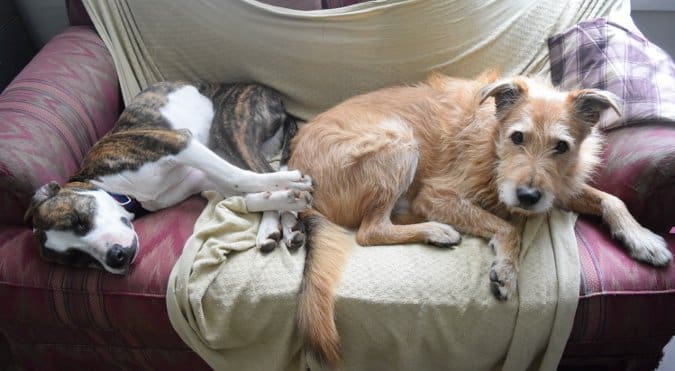
But I also know that I would probably describe myself in a similar fashion to those moms.
“I would love to do something like agility with them, but I just can’t seem to make the time to train.”
“Sometimes, when I see some new thing Woody has chewed up, I snap and yell, even if it’s really my own fault that he had the opportunity to snatch it.”
“I feel that I let Otto down by taking on foster dogs.”
I know that the makers of the “mom” video had a pre-planned agenda: They were allowed to watch their children’s assessments of them, and made to realize that no matter what they think of their own shortcomings as parents, their children really do appreciate everything they do for them.
I don’t know that our dogs can feel exactly the same type of conscious appreciation of us that our children can … but it made me wonder.
How would you describe yourself as a dog owner?
And how would your dog describe you as his or her owner?
Is There Such a Thing as Oldest Dog Syndrome?
My one-year-old dog Woody is maturing into a WDJ model, which is great for me; his ability to quickly learn a new behavior and to stand patiently in place while I change lenses or something gives me an additional option when I need to illustrate something for the magazine, or for a newsletter I sometimes produce (as a volunteer for my local shelter). Plus, he has a nice short coat; when I’ve had to take photos of collars or harnesses on a dog in the past, I’ve always had to borrow a friend’s (untrained and/or inexperienced) dog rather than use my professional model, nine-year-old Otto, because it’s hard to see gear on a fluffy or fuzzy dog model!
However, everyone I know is giving me flack about it! Friends, acquaintances, and even Facebook “fans” of WDJ are commenting about the plethora of Woody pics in the magazine lately (Woody modeled with a lot of items for a “gift guide” in the December issue). I’ve heard “I miss Otto!” from any number of people.
Even those closest to me, who know I haven’t abandoned Otto, are teasing me. “Poor Otto!,” my son commented on the pictures I posted of Woody posing with some pancakes (taken for that shelter newsletter, to advertise an upcoming pancake breakfast fundraiser). “I think the ones you took a few years ago of Otto and the pancakes were way better than these,” my husband chimed in!
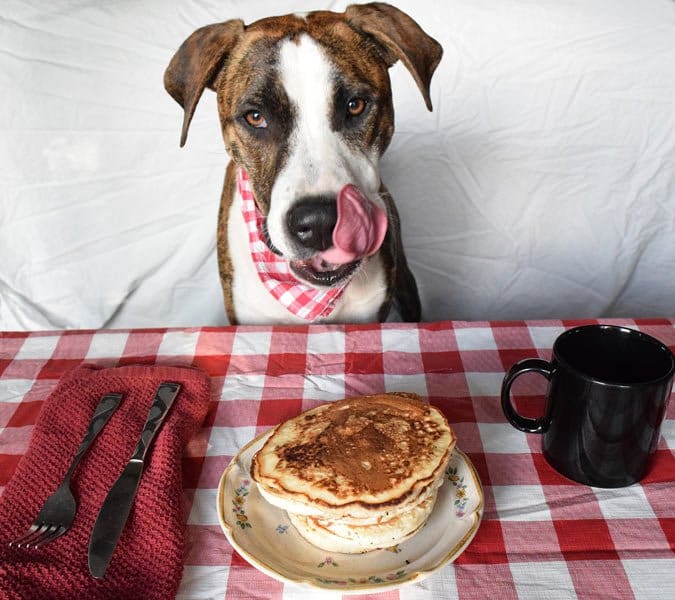
So, maybe I’ve gone overboard with using Woody lately. But anyone who has an older dog and a younger dog ought to be able to relate: When your older dog is behaviorally more or less perfect, and your younger dog still needs tons of guidance, practice, and management, you naturally find yourself spending more time with the young one. And if you are a training and behavior junkie like me – I love teaching dogs new things, and watching them figure stuff out! – then working with a “green” dog is just more interesting than working with Mr. Been There, Done That!
Also, I can’t yet leave Woody to his own devices for hours and hours on any given day, just yet. If we do a big hike on one day, then, yes, I could likely leave him for 6 or so hours the following day without anything being destroyed. But if we haven’t taken a good off-leash romp for a few days, his unsupervised time (indoors or out) has to be limited to just an hour or two, unless I don’t mind losing yet one more wooden thing (bamboo, rosebush, corner of the deck, etc.) to his restless chewing. So when I’m super busy, say, running a lot of errands, I tend to make sure he’s with me. Unlike Otto, he likes riding in the car, and is happy to run with me into Petco (home of Otto’s dreaded slippery floors) or the shelter (where Otto droops and starts panting in anxiety). Woody is happy to go anywhere, any time. So Otto gets left home with my husband, and I get teased some more about favoring “the new guy.”
I’m pretty certain there is some projection going on here, especially with my son and husband. Are they defending Otto because they, too, feel neglected? It’s possible.
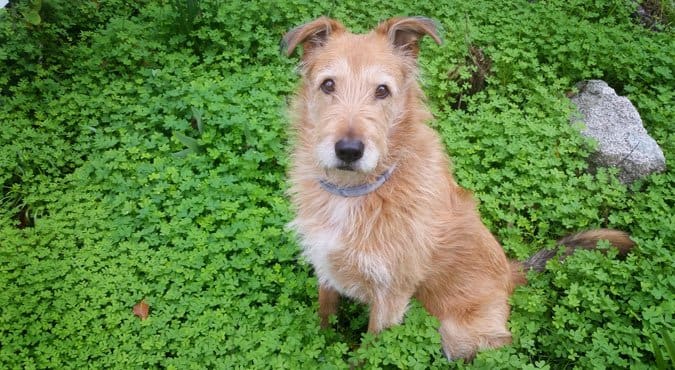
But I haven’t forgotten Otto, and I’m not neglecting him. He still gets privileges that Woody hasn’t earned, and he always gets fed first, and receives the choicest bits of leftovers. I bring him and leave Woody home when I go to visit friends, so he can get some special attention from friends who have known and loved him for a long time. And when I need a rock-solid “demo dog,” like when a friend asked me to bring a dog to juvenile hall to talk to young inmates about dog training and behavior, Otto is my go-to guy. He seems to really enjoy being the dog with all the right answers and performs all his tricks for audiences eagerly. (He slayed the crowd with his dramatic “bang, you’re dead” trick; he always throws in a deep moan or groan as he “dies” and then lies still. The guys cracked up and asked him to do it again and again.)
Having these two dogs in my life – one older, wiser, and more reliable, and one younger, more mischievous, and unpredictable – is kind of like having a really great husband, and a fun new boyfriend, too! J
Top 20 Essential Oils for Dogs
1. Carrot Seed (Daucus carota). Skin care, first aid, healing, scarring, skin conditions. Super gentle.
2. Cedarwood, Atlas (Cedrus atlantica). Improves circulation, helps deter fleas. Skin care.
3. Chamomile, German (Matricaria recutita). Also called blue chamomile. Skin-soothing anti-inflammatory. Burns, allergic reactions, skin irritations.
4. Chamomile, Roman (Anthemis nobilis). Intensely calming and antispasmodic. Wound care, teething pain.
5. Clary sage (Salvia sclarea). Different from common garden sage. Gentle, sedating, calming.
6. Eucalyptus radiata (Eucalyptus radiata). The gentlest, best tolerated, most versatile eucalyptus (there are many). Anti-inflammatory, antiviral, expectorant. Diffuse as room air cleaner, deodorizer, flea repellent.
7. Geranium (Pelargonium graveolens). Tonic, antifungal. For skin ailments, yeast overgrowth, fungal ear infections. Ticks dislike all rose fragrances, including this one.
8. Ginger (Zingiber officinale). Fresh, warm, spicy (don’t settle for ginger that smells stale, musty, or rank). Motion sickness, indigestion (see Peppermint), useful in massage oils for sprains, strains, dysplasia, arthritis.
9. Helichrysum (Helichrysum italicum). Horrible smelling, incredibly effective essential oil (some people and dogs do like it). Also called Immortelle or Everlasting. Heals skin conditions, cuts, abrasions, wounds, injuries. Relieves pain.
10. Lavender (Lavandula angustifolia). Used by the makers of pet aromatherapy products more than any other essential oil. Gentle, antibacterial, antipruritic (anti-itch), stimulates rapid healing, acts as a central nervous system sedative, very relaxing, deodorizing.
11. Mandarin, Green (Citrus reticulata). The sweetest essential oil, very relaxing. For fear, anxiety, stress. Avoid red mandarin, which is not the same, and use only organic green mandarin. This is not a distilled oil but is pressed from the rind of the fruit.
12. Marjoram, Sweet (Origanum marjorana). Pleasing, smooth herbal fragrance, calming, antispasmodic effects, strongly antibacterial. A recommended replacement for tea tree oil in blends for pets. Bacterial skin infections, wound care. Repels insects. Reduces undesirable behaviors of intact males.
13. Myrrh (Commiphora myrrha). Ancient resin with deep, warm, earthy fragrance. Anti-inflammatory, antiviral. Puppy teething pain, irritated skin. Boosts immune system. Opoponax myrrh (Commiphora erythraea) has similar properties and repels ticks.
14. Orange, Sweet (Citrus sinensis). Popular, uplifting, pleasant. Calms, deodorizes, repels fleas, treats skin conditions. Use organic sweet orange oil to avoid pesticide residues. Pressed, not distilled.
15. Peppermint (Mentha piperita). Digestive aid; stimulates circulation for injuries, sprains, strains, arthritis, dysplasia. Insect repellent. Relieves pain and itching. To prevent nausea and motion sickness, mix one tablespoon vegetable oil, seven drops ginger, and eight drops peppermint; give three drops orally.
16. Ravensare aromatica (Cinnamonum camphora). Gentle, antiviral, antibacterial.
17. Rose (Rosa damascena). Expensive, wonderful, makes any shampoo, spray, or grooming product luxurious. Stabilizes central nervous system. Calming. Add one to two drops to blends for itchy, irritated, or dry skin.
18. Thyme linalol (Thyme vulgaris, chemotype linalol). Common garden thyme has six known chemotypes, or chemical profiles. Thyme linalol is the most gentle and useful. Relaxing, antibacterial, antifungal without the harsh skin irritation associated with common thyme. Balancing tonic.
19. Thyme thujanol (Thyme vulgaris, chemotype thujanol). Like thyme linalol plus immune system stimulant, liver detoxifier, antiviral. Kurt Schnaubelt, PhD, founder of the Pacific Institute of Aromatherapy, recommends applying thyme thujanol immediately after a tick or tick bite is discovered in order to help prevent Lyme disease. For immune-boosting blends or when a powerful antibacterial is needed without caustic, skin-irritating effects.
20. Valerian (Valeriana officinalis). Relaxing, helpful for separation anxiety or fear of loud noises, storms, fireworks, new situations.
Read “How to Identify and Buy Therapeutic-Quality Essential Oils” for more information.
A RECIPE FOR “CALM DOG MIST”
When she manufactured pet products, Bell’s best-seller was Calm Dog Mist. To make it yourself, place one teaspoon vegetable glycerin, one tablespoon grain alcohol or vodka, one teaspoon sulfated castor oil, and 10 drops grapefruit seed extract in an 8-ounce cobalt blue, green, or opaque spritzer bottle. Add three drops valerian, two drops vetiver, four drops petitgrain, three drops sweet marjoram, and two drops sweet orange essential oil. Add seven ounces spring or distilled water (fill to top).
If desired, add several drops of flower essences such as Rescue Remedy or gemstone essences such as rose quartz. Shake well before using. Calm Dog Mist can be spritzed into your hands and massaged into the dog’s neck and chest, sprayed on bedding, or misted into the air.
5 Benefits of Trick Training Your Dog
[Updated February 6, 2019]
It’s fortunate that there are many positive training options for our dogs today! Increasingly, people are choosing to extend their dogs’ education past classes in good manners, and I strongly advocate following up those basic classes with a tricks class! Learning even just a few basic tricks is fun for you, your dog, and your potential audience! And while the benefits to you and your dog are many, I will describe my top five:
1. Trick Training Develops Patience.
Have you ever felt frustrated or lost your patience with your dog? Raised your voice or used coercion, or other training methods that made your dog uncomfortable? Guess what: You’re human! But your dog knows when you’re not pleased, and that’s likely to negatively affect his ability to learn, as well as potentially damage your relationship with him.
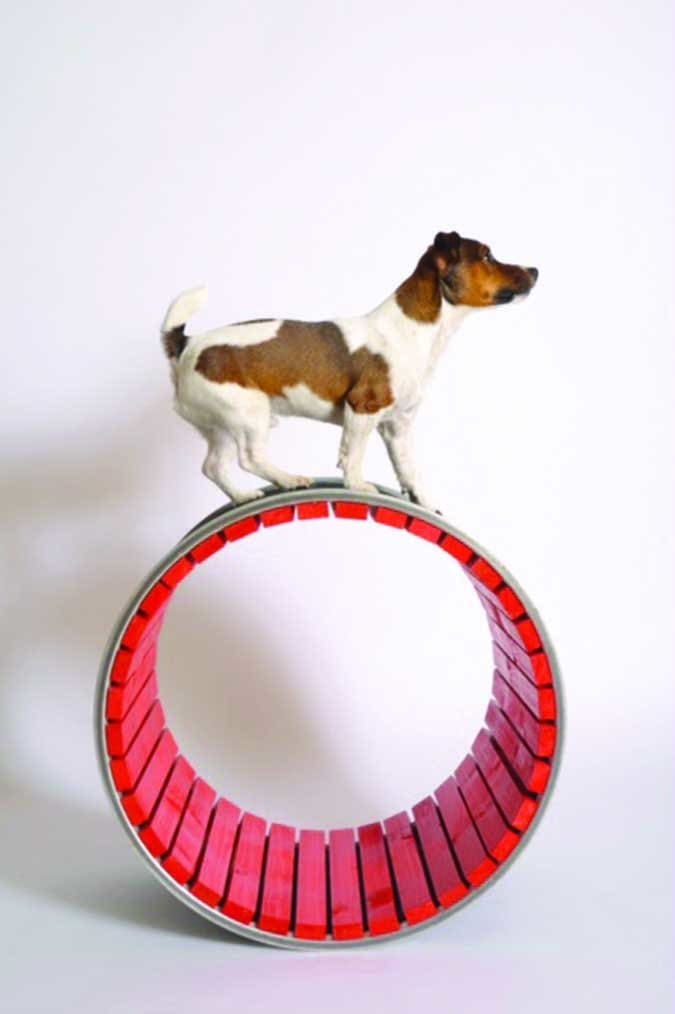
Training a dog to do fun (or funny!) tricks helps many owners let go of their expectations and just “be in the moment” of training their dog to do something in small steps. Perhaps it’s because the goal behaviors are “just tricks,” rather than behaviors that they feel their dogs must learn, lest they be judged as “bad owners”!
When you don’t expect instant results, it’s much easier to break down your training goal into a progression of small steps. This will make it much easier for your dog to succeed, you will be less likely to lose your patience, and the two of you will be much happier training together.
As an example, here’s how I taught my dog, Bella, to do a handstand. It took many steps and months to achieve, but the result was worth the effort and time.
First, she had to learn to back up. I had Bella standing in front of me. As I walked toward her she instinctively walked backward, and I marked the behavior with the “click” of a clicker and rewarded her. After enough repetitions, we had a nice “back” behavior.
The next step was getting her to back up and step with her rear feet onto something that was raised a little bit higher, and then, a little higher. I used pillows because they don’t slide away like a book might do, although large, heavy coffee-table books might have worked well). I placed the pillows next to a wall to keep them from sliding. Again, I accomplished this in a number of short sessions by marking and rewarding any of Bella’s increasingly correct efforts – a classic “shaping” technique.
Once Bella achieved a fairly vertical position, with her hind feet up on a quite high stack of pillows, I was able to ask her to back up to a wall in a spot where there were no pillows. Because we’ve done so much shaping, she was eventually able to figure out that the behavior that I would mark and reward was putting her rear feet on the wall. The repetition of backing and raising her rear legs gave her the strength and muscle memory to kick her back legs up and place them on the wall.
Each of these behaviors was practiced in numerous short training sessions. All the while, I was rewarding her with treats and loads of verbal praise, and she was slowly building endurance and gaining confidence. I mention strength because it is particularly important to not rush this trick. Think of it like this: If you were going to train for a marathon and hadn’t been running regularly, it might not be a wise idea to start running 10 miles right away. You could injure yourself because your muscles weren’t prepared for such an effort. However, when you run longer each week, your muscles slowly reach the level of conditioning that would lessen your chances of injury. When a dog does a handstand, he uses abdominal muscles that aren’t necessarily conditioned. Don’t be in a hurry!
To reiterate, when Bella was successful with the first step (backing), I stopped there. We had achieved our first goal, ended with positive results, and we were both happy. I got her to do what I wanted; I didn’t push it to the next level during that session.
As you can see, the process of learning a complicated or physically difficult trick can take some time. Keep your training sessions, particularly for a new trick, to a maximum of five to 10 minutes. Your dog will be less likely to get tired, bored, or frustrated – and you will be less likely to get frustrated. When you spend too much time on a particular part of a trick, especially if it’s not going smoothly, you may find yourself losing patience. Your dog will sense this and may become shy or timid, lose interest, or just shut down.
It’s okay to train more than once a day, but it’s best to space these short sessions out over several hours. Make sure to reward your dog and give lots of verbal praise. Your dog will have fun and be eager for the next training session. When I was teaching Bella her handstand, I only spent about five to 10 minutes on each new behavior. She could see I was pleased at the end of the session and was therefore so eager for the next training time that she often offered me the desired behavior before I asked for it. She learned in a stress-free manner and was ready to move on to the next step.
2. Trick Training is Fun for Both of You!
If you end your session on a positive note – and with tricks, it’s kind of hard not to, as it’s all fun and games! – you and your pup will walk away cheerful and satisfied.
I’m currently teaching my male dog, Mario, to jump in the air with a ball in his mouth. He knows how to take the ball in his mouth and he knows how to jump. I am trying to put the two together. When we’ve practiced, he’ll sometimes take the ball and then drop it at the jump cue. Or he’ll jump without picking the ball up at all.
However, he’s had moments of jumping with the ball in his mouth. When he achieves this behavior, I give him a jackpot – extra treats, fed one after another after another, and tons of verbal praise. Then I stop there. We are both genuinely thrilled about his success.
If you do not achieve your goal in a session, do your best to hide any frustration you may be feeling. Move on to a trick that your dog can already perform successfully and end with him receiving a nice reward. You can come back to the new trick later.
3. Trick Training Will Increase Your Dog’s Confidence.
Recently, an elated student in my tricks class told me that since she started teaching her dog tricks, the dog was showing signs of confidence, an interest in training, and an overall enthusiasm that my student had not seen before. She had no idea that this is often the case in tricks class!
For my part, I’ve noticed that Bella has gained confidence as she watches her brother, Mario. Mario is not afraid of moving objects and loves to ride a skateboard. When I first tried teaching the same trick to Bella, she was timid and reluctant to participate. After watching Mario do this trick over and over, on her own, with no prompting by me, she jumped on the skateboard to hitch a ride with him. Hooray! Now she insists on jumping on the board. She doesn’t yet push it on her own, but when I see that she’s ready, I may teach her to do this trick.
Mario also hops on top of and can balance on a rolling barrel; again, Bella used to be afraid of the moving barrel. Then, one day, she started going through the barrel. I reinforced this behavior, and with time, she gained the confidence to run in and out of this barrel while Mario is on top!
If your dog is a little timid, enrolling in a tricks class in your area may be a good idea. If your dog is in a room with other dogs doing tricks, he may gain confidence from even just watching the other dogs. If he’s like Bella, he’ll start to develop an interest in doing whatever is causing that upbeat, giddy behavior from the other dogs’ humans!
4. Trick Training Helps Your Dog with Distractions
Your dog will learn to work with distractions. Tricks classes present a dog with many distractions, but if you consistently reward your dog for watching you and listening for your cues, soon your dog will pay much less attention to extraneous stimuli in any setting when you ask him to focus.
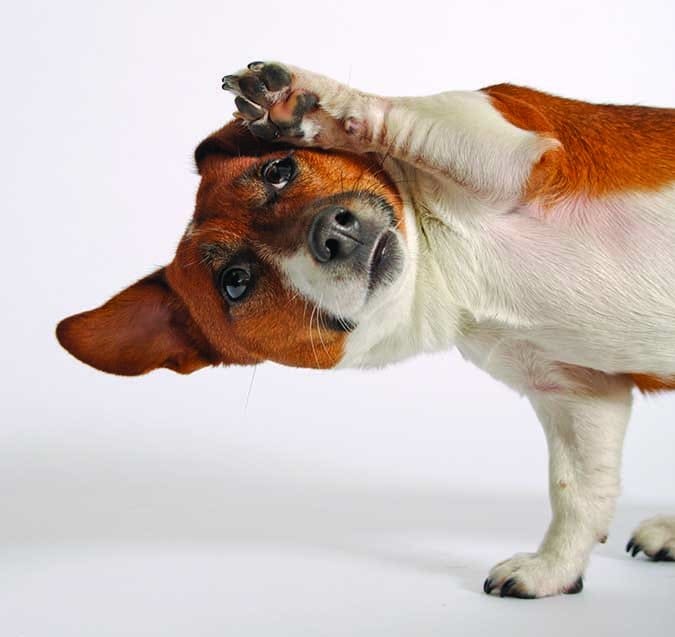
This ability to focus on you will come in handy when walking outdoors; it even increases your dog’s safety while he is walking with you near busy streets or crowded areas.
5. Tricks Let Out Your Dog’s Excess Energy
Does your dog seem to have excess energy and you don’t know what to do with it? Trick training may be the answer. Jack Russell Terriers, as well as many other breeds, tend to have an extraordinary amount of energy, but I’ve found that trick training helps channel that energy into behavior that I enjoy more! Mario and Bella are very calm and well-behaved, and I credit their trick training with at least some of their good behavior.
Many dogs who are bored will display undesirable behaviors, such as chewing or barking, that could put them out of house and home. This energy can be put to good use. Redirecting your dog’s excess energy into fun tricks, and enthusiastically praising him for his efforts, will likely make him increase the behaviors that make you happy.
BONUS: Trick Training Strengthens Your Bond
Taking a little extra fun time with your dog and practicing patience will both strengthen the bond with your dog and produce unique, enjoyable results. If a holiday family event gets dull, you can “wow” your relatives and spice up the party by showing off your dog’s amazing tricks. Those of you who take your dog to senior centers or work with children can share the tricks with a very willing audience. Your dog will relish the extra attention! In the end, you and your dog will build a strong and trusting bond, and that is the best reward of all.
With her two Jack Russell Terriers, trainer Marian DeAngelo of Rockville, Maryland, performs tricks for senior centers, libraries, schools, and birthday parties, and teaches dog trick training classes.
Aromatherapy for Your Dog’s Arthritis Treatment
[Updated October 3, 2017]
In addition to their use in teas, capsules, and other applications as discussed in last month’s article, “Herbal Remedies for Arthritis Pain,” medicinal plants provide pain relief and other benefits through their essential oils and hydrosols.
Essential oils – the volatile substances of aromatic plants – are collected, usually by steam distillation, from leaves, blossoms, fruit, stems, roots, bark, or seeds. The water that accompanies an essential oil during distillation is called a hydrosol or flower water. Hydrosols contain trace amounts of essential oil and are themselves therapeutic.
Aromatherapy for Dogs
It isn’t fragrance that imparts the medicinal properties of aromatic essential oils but rather their constituent chemicals.
Essential oils may contain anti-bacterial monoterpene alcohols or phenylpropanes, stimulating mono-terpene hydrocarbons, calming esters or aldehydes, irritating phenols, stimulating ketones, anti-inflammatory sesquiterpene alcohols, antiallergenic sesquiterpene hydrocarbons, and expectorant oxides.
In addition, each chemical category may have several different effects. Aromatherapy is a modern healing art, and the therapeutic quality of essential oils is still being discovered. In other words, aromatherapy is a complex subject that deserves careful study and expert guidance.
There are many ways to deliver essential oils into your dog’s environment. You can:
– Send them into the air with an electric nebulizing diffuser (available from aromatherapy supply companies).
– Add a few drops to a small spray bottle of water and spritz it around the room, being careful to avoid wood or plastic surfaces and your dog’s face.
– Place a drop on your dog’s collar, scarf, or bedding.
– Place two drops on your hand; then rub your palms together and gently run your hands through your dog’s coat.
– Add 15 to 20 drops of essential oil to eight ounces (1 cup) of unscented natural shampoo, or add one drop to shampoo as you bathe your dog.
– Add two to five drops essential oil to a gallon of rinse water, shaking well before applying (avoid your dog’s eyes).
Quality is critical when it comes to essential oils, and there is much debate over which oils, sources, production methods, and testing procedures are best. For therapeutic-quality essential oils and blends that can help your dog lead a comfortable, active life, see the suppliers mentioned in “Reliable Sources of Quality Oils” at right.

Essential Oil Blends for Dogs
At FrogWorks, Colorado aromatherapist Frances Fitzgerald Cleveland does more than consider which essential oils will work; she lets canine patients make the selection. “For any condition, there are several essential oils that could help,” says Cleveland, “and I let the dog smell each of them, usually by offering the cap. If she runs to the other side of the room or turns her head away, that’s not the right oil to use. Don’t ever force an essential oil on your dog. Wait for her to find an oil she’s interested in, one that she wants to smell more of. She may even try to lick the cap.”
This approach is called zoopharmacognosy, a term coined by Cornell University biochemistry professor Elroy Rodriguez, Ph.D., to describe how animals self-medicate with plants, soils, and insects to treat and prevent disease.
Sometimes dogs are cautious because a fragrance is unfamiliar. If your dog turns away from an essential oil, offer it again tomorrow or the next day. Once you’ve found an essential oil that will treat the problem and that agrees with your dog, Cleveland suggests blending it with an easily digested vegetable oil, such as cold-pressed safflower oil.
“Diluting essential oils for use with dogs is an important first step,” she explains. “I strongly believe that full-strength, undiluted essential oils are too strong for animals, who are very sensitive to essential oils and plant medicine. Some essential oils, due to their chemical constituents, can cause skin irritation if not diluted and, because their olfactory systems are much stronger than ours, dogs can be overwhelmed by undiluted essential oils.”
Cleveland created the massage oil she calls “Path to Comfort” for her dog Oscar. “He was so active in his youth,” she says. “His favorite activity was chasing rabbits and he was good at it. Then one day when he was 11, a rabbit came into the yard and Oscar got into his chase mode. The rabbit took off, but Oscar stopped, sighed, and laid back down. He looked so sad that I made a blend to help him cope with his senior years.”
To a safflower oil base she added sweet marjoram essential oil for its analgesic, nervine, and vasodilator (blood vessel dilating) properties; ginger for its antispasmodic benefits; helichrysum for its analgesic, anti-inflammatory, and nervine properties; carrot seed, which is a vasodilator and smooth muscle relaxant; grapefruit for its detoxifying and emotionally uplifting benefits; vetiver, which is a deeply relaxing antispasmodic; and rose otto, distilled from rose petals, which has antidepressant and antispasmodic properties.
You can use this blend by placing a small amount of the oil in your hands and applying gently to areas on the dog’s body that seem stiff, sore, or restricted, or massage a few drops into painful joints.
You can learn more about Path to Comfort, individual essential oils, other canine massage blends, and Cleveland’s home study course, “Working with Essential Oils for You and Your Animals,” at the FrogWorks website (see above).
Pet Alchemist aromatherapist Joan Clark makes a massage blend for acute pain relief that she calls “Arf-itis,” containing angelica, arnica, wintergreen, marjoram, peppermint, and tansy essential oils, in a base of arnica-infused oil, St. John’s wort, jojoba, fractionated coconut oil, flower essences, and lavender hydrosol. The blend is also available as a hydrosol mist, which can be sprayed on painful areas and gently massaged in.
“Both blends contain flower essences and the best in essential oils and carrier bases,” Clark says. “Regular application is needed to get the full benefits of natural treatments. Our two Chihuahuas, Spirit and Sabrina, loved this blend. Every evening before bed we massaged them and we applied it again in the morning and before any physical activity. As they got older we had Sunday Spa nights starting with a massage using the blend and ending with a warm towel over the area.”
Arf-ritis Pain Relief massage oil from Silk Road Oils was developed by canine aromatherapist Faith Thanas, who blends AromaDog Products. “This is a serious treatment for stiffness and arthritis pain in dogs,” she explains. “Rosemary and ginger increase circulation to the area, while juniper acts as a detoxifier, and lavender and birch calm and help relieve pain. The oils are blended with arnica and jojoba.
“This is one product that takes a little time, but you will soon see improvement. Place a drop on the affected area and gently massage it into skin.”
If you search online for “aromatherapy canine arthritis remedies” you’ll find many other recommendations. One popular blend combines 60 ml or 1/4 cup carrier (vegetable) oil with four drops of helichrysum, two drops peppermint, three drops ginger, and three drops valerian essential oil. Another combines 120 ml or 1/2 cup carrier oil with eight drops lemon, six drops lavender, and eight drops ginger essential oil.
Easy and Inexpensive Arthritis Relief for Dogs
It’s sad when our aging dogs slow down because of arthritis – and a joy when natural remedies that are affordable and easy to use provide relief from pain and discomfort. Incorporating medicinal herbs and essential oils into your dog’s daily schedule may help him act like a puppy again.
Next month, we’ll discuss assistive devices that can help support a dog with limited mobility due to arthritis or other issues.
A long-time contributor to WDJ, CJ Puotinen is the author of The Encyclopedia of Natural Pet Care and other books. CJ and her husband live in Montana.
Rules for Playing Tug
Some unenlightened trainers caution against playing tug with your dog, with dire warnings about dominance and aggression. Modern, educated trainers recognize that as long as you play tug in a manner that doesn’t reinforce unwanted behaviors, the game can be extremely beneficial. Tug is good exercise, can reinforce desirable behaviors, and has nothing to do with dominance. Here are a few important rules for safe and beneficial tug-play:
1. Your dog needs to wait for an invitation to play tug. Tell her to wait; then hold up the tug toy. If she jumps for it, say, “Oops!” and hide the toy behind your back. Repeat until you can hold up the toy and she doesn’t try to grab it.
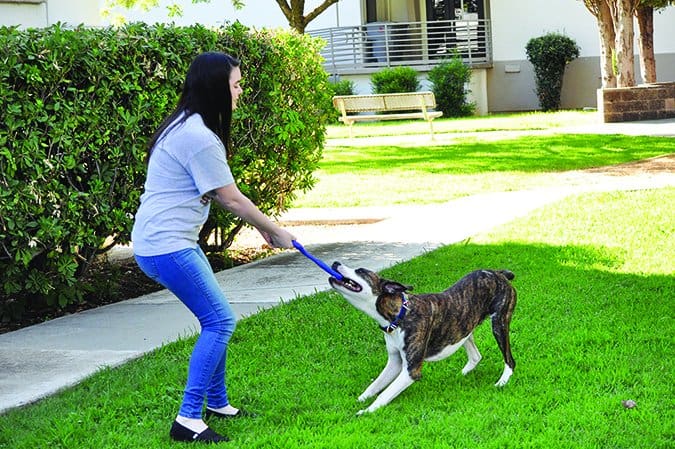
2. Now give her permission to grab the toy with your “Tug!” cue. Let her fiercely shake it back and forth and growl in play, while you hang onto your end and encourage her to tug.
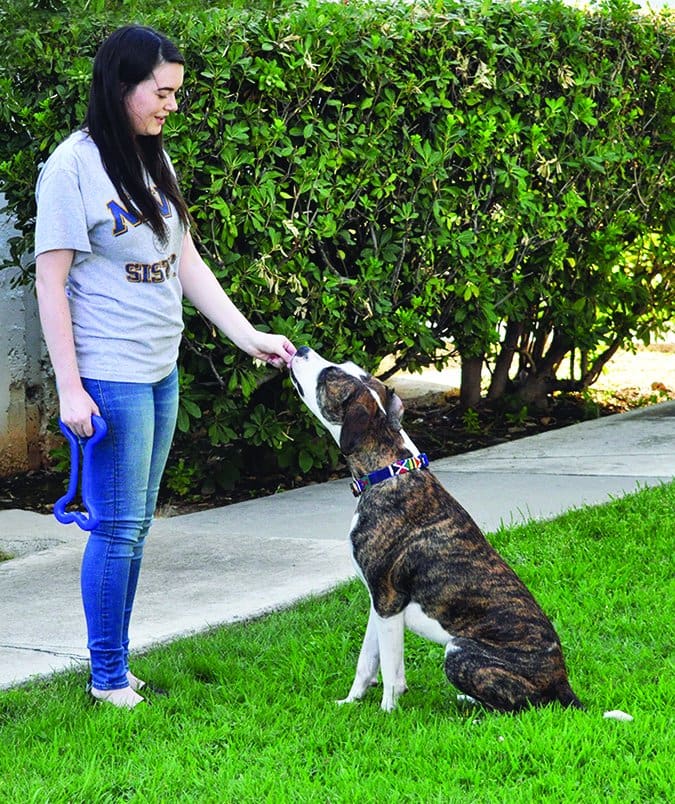
3. Occasionally ask her to “Trade” and offer her a treat in exchange for the toy. When she gives it up, return to Step 1 and ask her to “Wait” until you invite her to play again.
4. If at any time her teeth touch your skin or clothing, she gets an “Oops!” and the toy goes away for a few minutes. You can then initiate play again. If necessary to keep yourself safe, you can stand inside an exercise pen with her on the outside when you tug, until she learns the rules.
That’s it! I don’t care who “wins.” We can alternate! I don’t care who initiates play; he can bring me the toy and ask me to play, or I can pick up the toy and start the game. There’s just one last really important rule:
Have fun!
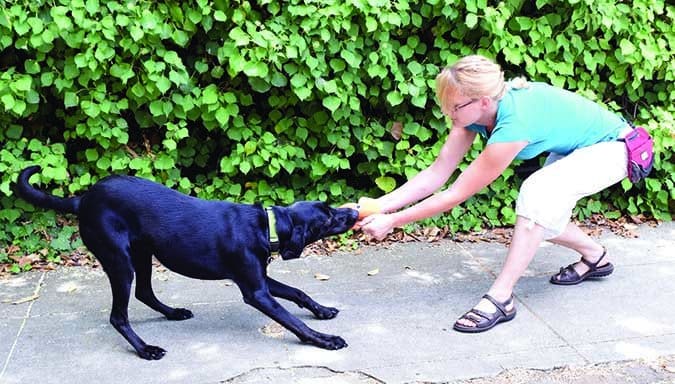
Dog Growling is a Good Thing!
Finishing up my morning chores, I am sweeping the barn aisle when I hear ferocious growling erupt in the feed room. Do I drop my broom and run to break up a dog fight? No, I chuckle to myself and keep on sweeping. I know that two of my dogs are playing tug with their favorite rope toy and that the ruckus is nothing to be concerned about. I can easily interpret the tone of the growling, and recognize it as healthy, mutually enjoyable play. Also, my experience and education in canine behavior has led to my understanding that canine growling, in all of its various presentations, is a good thing, not a bad thing.
In the old-fashioned dog training world, generally all growling was perceived as bad – an aggressive threat. Anything that elicited a growl from a dog was bad, too, which is why many dog owners have been warned against playing tug with their dogs – because it encourages aggression, as evidenced by the dog’s growls. I give myself a mental smack on the forehead every time I hear this; it’s inconceivable to me that some dog training “professionals” still perpetuate this myth despite all the evidence to the contrary. My clients are invariably thrilled when I give them permission – no, encourage them – to play tug with their dogs.
Modern trainers know that dogs growl for a variety of reasons, and that all growling communicates important information to an educated dog owner.
So what are the various kinds of growling, and why are they all good?
1. Play Growl
Like my dogs in the feed room, dogs often growl while playing, just as they exhibit other behaviors in play that are often associated with aggression, such as bites, snarls, muzzle punches, and body slams. Whether the growls happen during a rousing game of tug or a more physical play encounter, the key here is that the dogs know they are playing. Often accompanied by play bows and other body language cues that telegraph to the playmates that it’s all in fun, pseudo-aggression is just part of the game.
Some owners, uncomfortable with any growling, stop perfectly healthy play, preventing their dogs from engaging in a normal, beneficial social activity. In reality, dog-human tug is a great game: it’s good exercise, an excellent reinforcer for other behaviors, and strengthens the bond between dog and owner when they engage in a mutually enjoyable game. (See “Rules for Tug,” at right.)
In healthy dog-dog play, if Dog A starts to escalate his level of arousal to a level that makes Dog B uncomfortable, Dog B signals his discomfort with appeasing body language and Dog A tones it down a couple of notches. Dog A happily rejoins the fun, and the growling and biting resume.
Aggressive, aroused play goes sour when Dog A ignores Dog B’s discomfort and continues to escalate. Rather than happily continuing to engage, Dog B clearly tries to avoid the activity – often unsuccessfully as Dog A continues his pursuit. When this happens, Dog B may escalate to defensive aggression in order to try to get Dog A to back off.
While Dog B often gets blamed for “starting” the fight, Dog A is really the culprit. The problem here is not the growling, but rather Dog A’s inappropriate play style and poor social skills. It is appropriate for the human to cheerfully intervene (before the fight happens!) when one dog is clearly not enjoying the interaction.
2. “Talking” Growl
There are several breeds of dogs that are well-known for growling as a way of “talking.” Rottweilers are the most notorious for this, but there are many more. Just as the submissive grin is often mistaken for a real snarl by uninformed humans, the growly talking dog is often misunderstood by people who may think he is being aggressive. Not so!
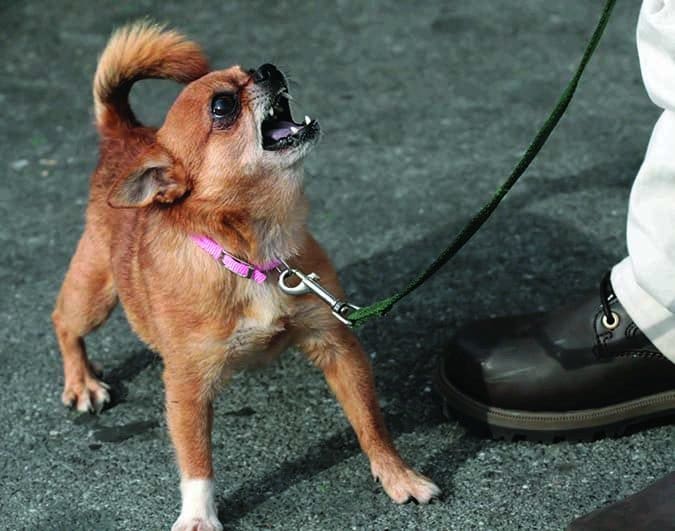
© Mikeworking | Dreamstime.com
That said, you have to pay attention to the entire package of body language with growly “talkers.” Perhaps your neighbor’s Rottie is leaning against you in what seems like a friendly manner. You oblige with a good butt-scratch. As your fingernails find that spot just above his tail, you feel the rumble of a growl vibrate though him. Yikes! Is he about to bite you? Should you stop scratching? It depends.
If the dog is still leaning against you, with relaxed ears, eyes a little squinty, and an open, relaxed mouth, this dog’s growl is just expressing his pleasure; he’s really enjoying his canine massage. If, however, he stands up, his body tense and still, his eyes hard, and his mouth closed, then yes, he has taken offense.
There’s a good chance it’s the first scenario, not the second. If you’re sure he’s loving it, resume scratching. If not, sit still, avoid eye contact, and calmly ask the dog’s owner to call him away. When the dog has moved away, explain to the owner what happened, and ask for her interpretation. Owners of growly dogs are sometimes pretty good at being able to decode their dogs’ messages. (But not always, so trust your own instincts, too!)
These dogs may also growl-talk as a means of communication in other situations, and the tone of the growl can even vary slightly, providing even more information to the educated ear. That deep grumble might mean, “I’d like my dinner, please,” while a higher-pitched, more intense growl might mean, “I need to go out to potty, now!”
3. Alert Growl
Your dog may also growl to let the rest of his social group (including you) know there’s something to be concerned about. A noise outside, or elsewhere in the house, may elicit what I call the “alert growl,” meaning, “Hey, everyone, pay attention! There’s something out there and I’m not sure what it is, but it could be a threat. Someone might want to check it out!!”
Often, if you do check it out and assure your dog that all is well (and thank him for doing his job), he’ll relax and go about his business. Absent that, he may feel the need to continue to warn about the perceived possible threat or intruder.
Of course, checking it out isn’t a guarantee that he’ll stop alerting. If he feels that something more needs to be done, he may continue his efforts to warn you that danger is afoot. If so, it may help to actually show him the source of the noise, so he can reassure himself that all is well.
4. Warning Growl
As long as they have not been punished for growling (and we’ll talk more about that momentarily), dogs will usually issue a warning growl to humans or another dog if they are uncomfortable. It’s important to understand that a warning is a good thing!
Most dogs don’t want to bite or fight. Social groups work because members tend to avoid violence, so a system of communication develops to facilitate avoidance of aggression. The behaviors that signal pending aggression are intended, first and foremost, to warn away a threat. The dog who doesn’t want to bite or fight tries his hardest to make you go away. He may begin with subtle signs of discomfort that are often overlooked by many humans – tension in his body movements, a stiffly wagging tail, a freeze, and hard stare, and more. “Please,” he’s saying gently, “I don’t want you to be here.”
If you ignore those signals and continue to invade his comfort zone, his threats may intensify, with more tension, a hard stare, and a low growl. “I mean it,” he’s saying more firmly, “I want you to leave.”
If those are ignored, he may become more insistent, with an air snap, a bump of the nose (called a “muzzle punch”), or even open-mouth contact that closes gently on your hand or arm but doesn’t break skin. “Please,” he’s saying, “don’t make me bite you.”
If that doesn’t succeed in convincing you to leave, or to stop whatever you are doing that’s worrying him, the dog may feel compelled to bite hard enough to break skin in his efforts to protect himself, his territory, members of his social group, or other valuable resources.
Aggression is caused by stress. The stressor may be related to pain, fear, intrusion, threats to resources, and past association or anticipation of any of these things. (See “Understanding Aggression in Dogs,” WDJ October 2010.) An assertive dog acts aggressively because he’s stressed by the intrusion of another dog or human into his territory. A fearful dog bites because he’s stressed by the approach of a human. An injured dog lacerates the hand of his rescuer because he’s stressed by pain.
How to Respond to a Warning Growl
Lots of humans who understand that the above-described growling situations don’t indicate aggression may still overreact to a growl that clearly is a warning and a possible precursor to aggression. The problem here is a failure to understand that a warning growl is a really good thing; it means he is doing his best to not bite you. A warning growl says, “I am very uncomfortable here… please don’t make me bite.
The appropriate human response, in this case, is to quickly determine what is making the dog so uncomfortable, and remove the stressor so he doesn’t feel compelled to bite.
It’s usually not rocket science. If you are walking your dog and he sees someone coming toward you on the sidewalk and starts growling while looking at him or her, that person is scary to him; quickly do a U-turn or step off the sidewalk or take other immediate action to put some space between your dog and the person that is scary to him at that moment.
If you are trying to put a new coat on your dog, and hear a warning growl, stop what you are doing and give him some space. He’s just told you that a slower approach to the coat, with some counter-conditioning and desensitization, is in order.
Unfortunately, the all-too-common human response to growling is to take offense. Many owners immediately think, “How dare you growl at me!!” They grab the dog’s collar, smack him, and/or thrown him on the ground in a misguided “alpha roll.” In some cases, the dog might be intimidated into silence, but in many cases, the punished dog will be pushed into biting the very human he was trying hard not to bite.
It can seem intuitive to punish growling. Growling leads to biting, and dogs who bite people often are euthanized, so let’s save our dog’s life by punishing him at the first sign of inappropriate behavior. I can see how it seems to make sense, but when you have a deeper understanding of canine aggression, it’s easy to understand why it’s always the absolute wrong thing to do.
When you punish a growl or other early warning signs (such as a snarl or snap), you may succeed in suppressing the warning behavior, but this doesn’t remove the stress that caused the growl in the first place. Actually, you increase the stress, because now you, the dog’s owner, have become unpredictable and violent as well. If you succeed in suppressing the warning signs, you end up with a dog who bites without warning. He learns that it’s not safe to warn.
If a dog is frightened of men, he may growl when a man approaches. You, conscientious and responsible owner, are well aware of the stigma – and fate – of dogs who bite people, so you punish your dog with a yank on the leash and a loud “No! Bad dog!” Every time your dog growls at a man you do this – and quickly your dog’s fear of men is confirmed: men do make bad things happen! He likes men even less, but he learns not to growl at them to avoid making you turn mean.
In contrast, you think he’s learned that it’s not okay to be aggressive to men, because the next time one passes by, there’s no growl. “Phew,” you think to yourself. “We dodged that bullet!” Convinced that your dog now accepts men because he no longer growls at them, the next time one approaches and asks if he can pet your dog, you say yes. In fact, your dog has simply learned not to growl, but men still make him very uncomfortable. Your dog is now super-stressed, trying to control his growl as the man gets nearer and nearer, but when the scary man reaches for him he can’t hold back any longer – he lunges forward and snaps at the man’s hand. Fortunately, you’re able to restrain him with the leash so he doesn’t connect. You, the dog, and the man are all quite shaken by the incident.
It’s time to change your thinking.
A warning growl is a dog’s cry for help. It’s your dog’s way of telling you he can’t tolerate a situation – as if he’s saying, “I can’t handle this, please get me out of here!” Instead of making things worse, heed the warning. Help your dog out of the situation that’s causing him discomfort, and take behavior modification steps to help him become more comfortable with the stressor.
The next time your dog growls, don’t panic. Just determine what kind of growl it is, and respond appropriately. Now, go play some tug!
Author Pat Miller, CBCC-KA, CPDT-KA, is WDJ’s Training Editor. She and her husband Paul live in Fairplay, Maryland, site of her Peaceable Paws training center, where Pat offers dog-training classes and courses for trainers. Miller is also the author of many books on positive training. Her newest is Beware of the Dog: Positive Solutions for Aggressive Behavior in Dogs (Dogwise Publishing, 2016).


